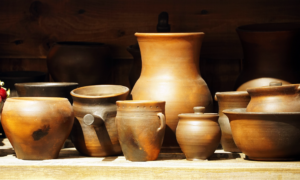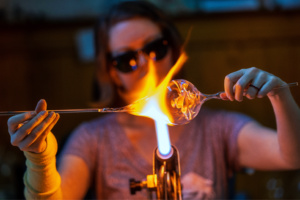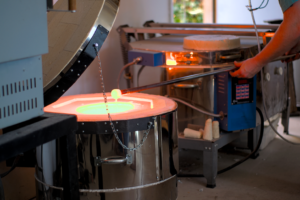When introduced to the world of lampworking, you may find yourself fascinated by the intricate and detailed works that are made possible by this technique. As one of the multiple glassworking methods, lampworking provides artists and creators with the opportunity of manipulating glass to their heart’s desire.
Lampworking is ideal for smaller-scale creations, such as beads, jewelry, and other art pieces. To immerse ourselves in the process of lampworking, we first need to understand its origin and impact throughout time.
Breve history
Lampworking is a technique that was first practiced in Italy during the 14th century. The island of Murano located north of the country is still known for its beautiful artisanal glass creations to this day. This technique fully developed as an art form; spreading all over Italy, other European countries, and eventually, the rest of the world.
Since then glass craftsmanship has allowed creators to demonstrate their skills through the production of beads, figurines, lenses, marbles, and other art pieces. Looking at the patterns, lines, and colors in the pieces created by lampworkers shows how free flowing the art of shaping glass is.
Lampworking processes
The process of lampworking involves molding molten glass using several specialized tools. There are many different shapes and styles an artist may achieve when practicing this technique. Stringer application creates curves and lines on a piece, producing scrollwork designs and even typographic decorations.
Another common practice is to create dots or plunged dots, which integrates an embossed look into the artist’s work. To achieve a more organic appearance, mixing different colored glass is possible through raking, which merges the materials in the shape of flowing curves.
For more sophisticated results, there is encasing. This technique covers a fully finished bead with clear glass. Lastly, another common style of lampworking is implosions, typically seen in marbles. This refers to creating volumes and shapes within a clear piece of glass.
As a very complex art form, it requires mastery and skills that can only be acquired through practice.
Safety is also a very important aspect of the craft since it involves activities that could be harmful or cause serious accidents. Preferably, having the support of an experienced lampworker is the best way to go about entering this field. Designing glass pieces will allow artists from all backgrounds to explore the endless creative possibilities lampworking allows for. Combining styles and techniques will result in pieces that are truly one of a kind.
Lampworking tools and supplies
Molten glass is the medium through which lampworking can shine. The behavior of glass is very particular, therefore lampworkers need to be very familiar with the different conditions under which it may either transform or break. There are also several different kinds of glass, categorized under ‘soft’ and ‘hard’ glass. The latter category includes borosilicate glass, which is one of the most common materials used in lampworking nowadays.
The benefits of using this type of glass are that it shrinks less than other types of glass and it reacts well when exposed to rapid temperature changes, making it less likely to crack. However, its color selection is less varied and generally, the cost of this material is higher.
Lead and soda-lime glass belong in the soft glass category, which is characterized by its lower melting point and higher shrinking rate. These are also extremely popular due to the variety of colors available, and the fact that they are more traditional materials for the craft.
It is important to consider the chemical compatibility of the selected materials so there are no future problems when finishing a piece. A creator must be aware of their material’s coefficient of thermal expansion (COE), which refers to the changes in the size of a piece of glass after the temperature around it changes as well.
Combining glass types with different COE is highly discouraged, since it may result in cracking, shattering, or other effects like discoloration, bubbling, or devitrification.
How to practice lampworking?
After designing a piece and selecting the right glass, it is time to start lampworking. Heating glass at the right temperature and shaping it with the right tools will allow for better pieces. Raw glass materials for lampworking come in a rod, tube, sheet, or frit format so that they can be manipulated under heat.
The main tools for heating glass are a bench top torch , a hand torch, and a kiln. Each of these tools plays a different role in the process, providing different results when molding glass. The bench top torch provides a stable flame that remains still, the hand torch allows for movement and direction of the flame, and the kiln is used at the end of the process so the piece at hand may anneal.
Annealing refers to heating a piece of glass until its temperature reaches a stress-relief point, which means that the glass is still too hard to bend but it is soft enough for its internal stresses to be relieved.
After that, the piece must be soaked in heat until its temperature is uniform throughout. The piece must then be cooled at a slow rate so that its internal temperature goes below a critical point and there are no internal stresses, allowing it to drop to room temperature safely. If the process of annealing does not occur, the piece may crack or shatter when facing minor temperature changes or other shocks.
Lampworking vs. Glass Blowing
The most evident difference when comparing pieces created through lampworking versus glass blowing is scale. Both techniques may use the same materials, but the results vary greatly in size. Mainly because glass blowing uses larger tools, it is traditionally applied towards the manufacturing of vases, ornaments, plates, and other larger art pieces.
Glassblowing uses a very hot furnace to heat the glass to the state of white-hot, while lampworking uses a smaller torch. Glassblowing also requires pieces to be hollow, because the technique involves blowing air into the material. Smaller, more solid pieces are produced through lampworking. This happens because of the size of the tools as well, but also because the technique revolves around rolling and twirling solid molten glass instead of blowing into it.
It is a more precise and delicate practice, ideal for those who enjoy focusing on small details and having more control over the textures and lines of a glass piece.
Lampworking kit
The lampworking tools required to achieve fully finished lampworking pieces may be summarized into two categories: heating and shaping tools.
- Heating Tools
Three heating tools were previously mentioned: the bench top torch , hand torch, and kiln. The first two allow for the lampworker to bend glass pieces as desired, while the last one makes sure the temperature changes that the piece goes through are stable enough for it to remain intact until it reaches room temperature, and it is ready to either use or display safely.
- Shaping Tools
Now in terms of shaping tools, the mandrel would be one of the most essential instruments used by lampworking artists. A mandrel is a stainless-steel rod around which glass is shaped.
It is important to use bead-release formula, a mixture that prevents the glass from sticking to the mandrel while it is being wrapped. Other common shaping tools are paddles, mashers, tweezers, and picks. All of these give the final product several different finishes and styles that can be combined for rather unique results.
There are also reamers, shears, claw grabbers, and lathes. Reamers are specifically used for bead making since they allow artists to open a space in the middle of the bead, so a string may go through it.
Shears are used for cutting molten glass and use only the necessary amount when molding a piece. Claw grabbers are for holding hot glass safely, so that the lampworker may rotate it and move it as needed. Lathes rotate pieces son indentations and textures may be added to their surface.
Another tool that is very common among lampworkers is a marver, which is a flat piece of material that can be used to shape beads. This surface is usually made from graphite, which draws heat out of the bead, so this can create interesting effects on special glass that have certain properties. These effects may include changing colors while alternating between heating and cooling.
A marver can be torch mounted or handheld, depending on the degree of manipulation the artist may need to achieve.
Our best advice before your purchase…
Finally, a very important part of assembling your lampworking kit involves having the proper safety equipment and measure. It is recommended that lampworkers wear protective glasses or goggles and heat-resistant gloves. Ideally, the best safety glasses for lampworking, should have didymium lenses, so they can protect you against UV rays and sodium flare from a torch.
It is also important to consider that this practice includes the risk of provoking a fire, therefore you should have a fire extinguisher, smoke detector, and carbon monoxide detector by your side whenever you work with any heat or fire sources. It is also very important to ensure the ventilation of the workspace so that no fumes from the fuel and heat tools cause further respiratory issues.
Finally, make sure to be wearing non-flammable clothing and closed-toe shoes in order to protect yourself from any bodily harm while lampworking.
We have the best lampworking kilns!
Knowing all this is the first step towards becoming fluent in the language of lampworking. In your journey, it is most important to enjoy the learning process and dive into the different possible styles, so you may find your own ways of expression. The impressive works of a lampworker are only possible through experimentation, which is an essential part of the practice. Lampworking is sure to be a challenging but worthy craft that demonstrates human abilities, creativity, and mastery over matter. Don’t forget to contact our team if you want to start developing your skills with the best lampworking kilns!






